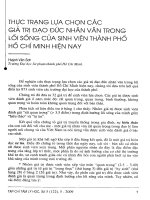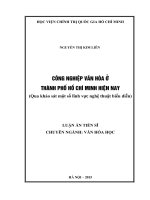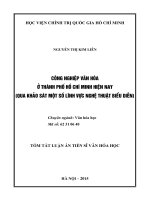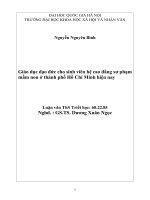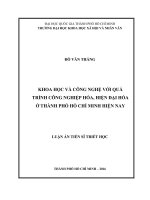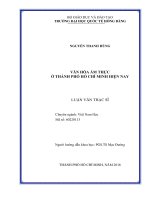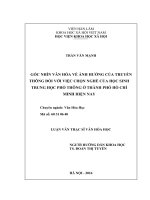Văn hóa ứng xử với người đã mất trong đời sống gia đình ở thành phố hồ chí minh hiện nay tt tiếng anh
Bạn đang xem bản rút gọn của tài liệu. Xem và tải ngay bản đầy đủ của tài liệu tại đây (405.04 KB, 27 trang )
VIETNAM ACADEMY OF SOCIAL SCIENCES
GRADUATE ACADEMY OF SOCIAL SCIENCES
L
TRAN VAN HUAN
BEHAVIORAL CULTURE TOWARDS THE
DECEASED IN THE FAMILY LIFE IN HO CHI MINH
CITY TODAY
Major: Sociology
Major code: 9.31.03.01
SUMMARY OF THE DOCTORAL DISSERTATION
IN SOCIOLOGY
Hanoi - 2019
The dissertation completed at Graduate Academy of Social
Sciences, Vietnam Academy of Social Sciences
Supervisors: 1. Assoc. Prof. Dr. Mai Van Hai
2. Dr. Truong Xuan Truong
Reviewer 1: Prof. Dr. Dang Canh Khanh
Reviewer 2: Assoc.Prof. Dr.Sc. Bui Quang Dung
Reviewer 3: Assoc.Prof. Dr. Pham Van Quyet
The dissertation will be defended at Graduate Academy Level
Council of dissertation assessment at Graduate Academy of
Social Sciences, Vietnam Academy of Social Sciences
Time: ………… date ………. month …… …year 2019
The dissertation may be found at:
- Vietnam National Library;
- Graduate Academy of Social Sciences Library
INTRODUCTION
1. The urgency of the research topic
After more than 30 years of Doi Moi, behavioral culture towards the
deceased in the family life in our country has been changing very strongly
both content and form. Of course, this change has brought about great
impacts on the community and society on both positive and negative
aspects. Positively, just as scholar Vu Khieu wrote: “since the unification,
everywhere in the country, especially in recent years, the family issue has
been particularly concerned. Almost every family reset the incense bowl to
worship ancestors, churches and graves are rebuilt. Family annals are
retrieved, recorded and disseminated. Due to the needs of family
sentiment, people in the family are frequently visited each other. The days
of meeting or ancestral anniversaries attract many people” (Vu Khieu,
1996: 8). These positive changes contribute to the success of the
movement of “all people unite to build a cultural life” and the movement
of building “cultural family” were launched by the Party and State.
In addition to the positive aspects, in recent years, the practice of
behavioral culture towards the deceased in the family life also has many
manifestations that are too far-fetched or deviant. In the general context of
the country, behavior towards the deceased in Ho Chi Minh City (HCMC)
is no exception. Recently, under the impact of industrialization,
modernization, globalization, international integration and market
economy to the traditional culture, in which, behavior towards the
deceased in the people’s family life is also changing with deviant
manifestations and far away from fine habits and customs. It is not a rare
phenomenon that funerals organize singing through the night and take
place in many days, as well as indulging in drink, playing cards, even
fighting each other in the death anniversaries. This fact is demanding to be
thoroughly learnt by scientific methods, as a basis for setting out policies
to manage and develop society in a sustainable manner, in accordance
with the times.
Meanwhile, on the scientific front, studying on family culture has not
kept up with what is happening in life. The Japanese researcher Michio
1
Suenari, through his studies in Hue, noted: “Regarding ancestor worship in
Vietnam, most of the essays so far are on the thought level, therefore,
there is a lack of information that tells us how the ancestors are being
worshiped” (Michio Suenari, 2010: 103). Thenceforth, the author conducts
research project titled “Behavioral culture towards the deceased in the
family life in Ho Chi Minh City today” as his doctoral dissertation, with
the hope of bringing a relatively comprehensive, systematic and new
understanding, contributing to solving the pending problems.
2. Research purpose and tasks
2.1. Research purpose
General purpose: the study aims to bring a relatively comprehensive,
systematic and new understanding on behavioral culture towards the
deceased in the family life in HCMC today.
Specific purpose: theoretically, the study tries to clarify and regularize
all 3 customs including funeral, grave and worship by a common concept
of “behavioral culture towards the deceased in the family life”, in other
words, the behavior between the living and the dead – besides familiar terms
such as the behavior between husband and wife, parents and children and
among siblings each other. Practically, the study contributes to raising
people’s awareness and providing scientific arguments for managers in
mobilizing the construction of “cultural families” in residential areas.
2.2. Research tasks
The author reviews previous research works and attempts to inherit the
lessons learned, especially the detection of gaps to clearly see his new
research direction; building a common concept that can contain all aspects
of funeral, grave and worship. The common concept is “behavioral culture
towards the deceased”; analyzing and evaluating the practice of behavioral
culture towards the deceased in families in HCMC today, and exploring
the difference among social groups in behavior with the deceased;
generalizing the analytical results as a basis for recommendation to solve
2
the shortcomings and pending problems in practicing behavioral culture
towards the deceased nowadays.
3. Research subject, object and scope
3.1. Research subject: behavioral culture towards the deceased
(including 3 aspects of funeral, grave and worship) in the family life in
HCMC today.
3.2. Research object: families in HCMC today
3.2. Research scope: Spatially, HCMC, namely, Ward 14, District 4
and Tung An commune, Cu Chi district. Regarding time, during last 5
years. The surveys are conducted in 2 stages: stage 1 was January 2018,
stage 2 took place in March 2018. Regarding research issue - behavioral
culture towards the deceased in Vietnamese family life.
4. Methodology and research methods
4.1. Research questions
How behavioral culture towards the deceased is taking place in families
in HCMC today? Is there anything new in this behavioral culture
compared to previous periods? If there is a new development than before,
what are social reasons have led to such changes? Are these changes
random, immediate or normative, and how does this affect the lives of
families, communities and society?
4.2. Research hypotheses
Compared to the past, behavioral culture towards the deceased in
HCMC today has been changing dramatically all three aspects of funeral,
grave and worship. This is reflected by reconstructing the old model and
adding more new features that had not existed ever. These changes
originate from many different reasons- that is the people’s economic life
has been raised; the process of industrialization, modernization, market
economy, globalization and international integration; the Party and State’s
guidelines and policies, as well as local organization, management and
customs. These changes are not random or immediate but are normative. It
is an indispensable product of Vietnamese society that is transforming
from traditional agricultural civilization to modern industrial civilization,
3
from subsidized mechanism to market one with the influence of
globalization trend and international integration.
4.3. Methodology
The study relies on Marxism-Leninism, namely, the historical-specific
perspectives and the relationship between social existence and social
consciousness as a methodological basis to describe, analyze and explain
the posing problems in the research process.
4.4. Research methods
4.4.1. Reviewing literature: including more than 100 documents such
as published works, articles, theses, dissertations at home and abroad.
4.4.2. Direct interview with questionnaires: including 575 cases in
HCMC. Respondents play a decisive role in their family, the sample size
is distributed appropriately by gender, age, education level and so on.
4.4.3. In-depth interviews: 30 cases are equally divided into 2 areas, in
which account factors such as gender, education level, age, living
standards, resident place. In addition, the interviewees also include 10
cultural staffs from ward and communal level to city level.
4.4.4. Observation and taking notes: using camera and notebook to
record related issues and images.
4.4.5. Group discussion: 2 discussions in 2 areas, each group has 8
participants, in which, account to their demographic characteristics.
5. New contributions of the dissertation
By approaching perspective of sociology, the dissertation has given a
relatively comprehensive, systematic and new understanding on behavior
towards the deceased in the family life through 3 components including
funeral, grave and worship in both theoretically and practically.
6. Theoretical and practical significance of the dissertation
6.1. Theoretically
To address the research purpose and tasks as mentioned above, the
study attempts to conceptualize practical activities of funeral, grave and
worship into a scientific concept that is behavioral culture towards the
deceased in the family life, thereby, enriching the treasure of concepts and
terms of subjects such as family sociology, cultural sociology. The
4
application of subculture theory, rational selection and modernization also
contribute to verify their popularity and accuracy in the concrete condition
in Vietnam today.
6.2. Practically
On the one hand, the study contributes to raising people’s awareness
and providing scientific arguments for managers and policymakers on
“building the cultural families”; on the other hand, according to
international practice, the dissertation’s results may be seen as premise for
the repeated studies in the future.
7. Structure of the dissertation
Besides the introduction, conclusion and recommendation, references
and appendix, the dissertation includes 5 chapters. In which, chapter 1 & 2
review literature and build up theoretical and practical basis. Chapter 3, 4
& 5 present empirical research findings, each chapter explores one aspect
that is funeral, grave and worship. This structure reflects the overall and
integrity of the study while simultaneously maintaining the relative
independence of the components.
Chapter 1
LITERATURE REVIEW
1.1. Regarding published research results
1.1.1. The general conception on behavioral culture towards the
deceased
By reviewing domestic research works (by Dang Nghiem Van, Tran
Quoc Vuong, Pham Xuan Nam, Pham Van Dong), as well as foreign
research works (by G. Mancacaritadipura, T. Sugiura and so on), the
author points out that the humane behavior towards the deceased is a
universal cultural phenomenon of all humanity. However, the phrase “the
deceased” needs to be understood in both ways – being a person who
deserves well of the people and the country and family’s relatives in
particular.
5
1.1.2. The origin of behavioral culture towards the deceased
According to Russian researcher X.A. Tocarev, behavioral culture
towards the deceased has an ancient basis of all things, the instinctive fear
of death, and it is also an attachment, does not want to be far away from
fellow-creature’s corpses. In the primitive cultural work, E. Tylor argues
that such behavior stemmed from the conception of animism of the ancient
people. In fact, since the Shang Dynasty in China, the worship has existed
as a custom.
In Vietnam, Dao Duy Anh and Dang Duc Sieu argue that, according to
the Vietnamese people’s folk beliefs, people have two parts including soul
and body. When someone died, the soul will leave the body but still
surrounds descendants to protect them, so the descendants must worship.
Foreign scientists studying Vietnam such as L. Cadière, E. Diguet and O.
Salemink also have similar views. L. Cadière also affirms that "it is
believed that the deceased still live close to the livings like people believe
in sunlight or the weight of plumb-bob”.
1.1.3. The basic components in behavioral culture towards the
deceased
On funeral: in Thọ mai gia lễ and Gia lễ chỉ nam showed that, in the
funeral, there are many rituals such as chiêu hồn, mộc dục, phạn hàm, phạt
mộc, nhập quan, thành phục, phường bát âm. In modern era, there are new
rituals such as death notice, celebrate the memory of the deceased, funeral
ceremony. Funeral associates with mourning clothes. According to Phan Ke
Binh “sons, daughters and daughters-in-law wear white mourning head-band
and clothes with a belt by a banana yarn outside. Paternal grandchild will
wear mourning cap, while mourning head-band and while dress. He also
argues that, after the burial, descendants must also practice many rituals such
as ngu tế, chung thất (49 days), tốt khốc (100 days), tiểu tường, đại tường and
burning votive paper.
On grave: because of the conception of “living for graves”,
Vietnamese people attach much importance to the grave, before burying,
people often invite geomancer to choose land so that after 3 years will
rebury (also known as exhumation). Depending on the family’s
6
circumstances, graves can be covered by soil or built in brick and stone.
On death anniversaries and festivities, descendants often visit to the
graves, repair and burn incense on the deceased graves. The graves are not
only taken care by descendants but the State law (Gia Long law) also has
very specific provisions to protect graves.
The worshipping ceremony: Tocarev argues that, in China, Korea and
Japan, every family has an ancestor altar to celebrate the death
anniversary, people who practice the ritual must be patriarchs. According
to Nguyen Duy Thieu, in Laos, this work takes place during the festival
Boun Pi May. In Vietnam, the worship of the ancestors takes place at the
ancestral temple while family death anniversary takes place in each
family; burning incense on the first day and the fifteenth day of the lunar
months and offering votive paper and then burning them.
1.1.4. Social impacts and posing problems: Researchers believe that
behavioral culture towards the deceased has both positive and negative
impacts: Positively, because it is a social development aspect (E. Quiroz),
protecting the diversity of culture (Chu A, Truong Chan Vi), turning the
past power into the present power (Vu Tu Lap), as the expression of
values and the unity of the group. Negatively, it contains the division (R.
Janelli), easily commercialize (E. Quiroz), causing trouble (Phan Ke
Binh). This is not to mention the expensive banquets and feasts (Luong
Van Hy, J. Kleinen), environmental pollution and the deformation of
beliefs (J. Wang).
1.2. Preliminary comments on content and methods
In general, the previous authors have built a pretty and vivid picture on
behavioral culture towards the deceased in the family life in three separate
areas: funeral, grave and worship by both awareness and practice.
Theoretically, however, so far the concept of behavioral culture towards
the deceased in family life has not been clearly defined for both internal
and external aspects. In terms of methods, someone uses quantitative
7
method, another uses qualitative method while many people just approach
research objects through books and their own experiences. This means
that, there is still lacks of a general and unified methodology.
1.3. The inheritance and research orientation
The dissertation is not only the inheritance of knowledge of previous
authors, from the sociological perspective, the study also tries to
contribute new knowledge to the picture.
Sub-conclusion of chapter 1: the dissertation considers reviewing
literature as an indispensable work so as to withdraw lessons that not only
help this study in the right direction but also avoid the situation of “trying
to push the door but actually it was opened for a long time”.
Chapter 2
THEORETICAL AND PRACTICAL BASIS
2.1. Definition and interpretation of concepts
2.1.1. The concept of family life: Every person, as well as community and
society is always living in 3 environments: natural environment, social
environment and inner life. The family life also consists of three areas:
economics- material (corresponding to the natural environment), behavior
among members (social environment) and spirit-spirituality-beliefs (inner
life).
2.1.2. The concept of behavioral culture: in the context of society,
people need to have appropriate behavior. So behavioral culture can be
understood to be the way of communication, protocol and rituals, patterns
of human behavior. In short, it is the objectification of the common
thoughts and feelings of a group of people, whereby the community and
society can operate smoothly.
8
2.1.3. The concept of behavioral culture towards the deceased (in
general): Behavioral culture towards the deceased can be defined as
behavior of the living with the dead and covering a wide range from
funeral and building graves to the worshipping by the livings. But
behavioral culture towards the deceased also divided into many levels:
family-clan, community, nation-ethnic group.
2.1.4. The concept of behavioral culture towards the deceased in
Vietnamese family: If considering Ego (me) as a standard, the behavior is
not only counted backwards to the predecessor generations (such as
parents, grandparents, great-grandfathers) but also includes spinsters,
deceased youths, or those who died prematurely.
2.2. Generalizing the original concept
That is the concept of behavioral culture towards the deceased (see
diagram below):
Behavior with the
deceased
Funeral
Graves
Worship
The indicator in this diagram just stops at the first level, and in the
study, it is further manipulated to the experimental indicators, this means
we can observe and measure in the field.
2.3. The theoretical approach of the study
This study utilizes 3 theories: first, reasonable choice theory, the
typical authors are G. Homan, P. Blau and J. Coleman. This theory shows
that, in the social actions, someone often compares the advantages and
9
disadvantages, the gain and the loss to make decisions so as to maximize
the gain and minimize the loss. Second, the subculture theory with its
basic spirit is, in each culture, in addition to the overall culture, each group
has its own subculture and this can dominate their behavior. Third,
modernization theory, it argues that modernization is a process in which
phenomena are replaced by new and more advanced ones, thus, it is
perceived to be better (G. Endruweit & at al). By selecting these theories,
the dissertation not only considers them as a guideline, but also an
opportunity to verify their popularity and accuracy through experimental
research in Vietnam.
2.4. Research sites
The survey and research area of the dissertation is HCMC, namely,
Ward 14, District 4 and Trung An Commune, Cu Chi District. First of all,
the study chooses HCMC because this is a place with a dynamic market
economy, a diversified occupational structure, high urbanization rate, and
as a gateway of exchange activities of the country and international
exchange. Generally, this is a typical area for Vietnam’s industrialization,
modernization and international integration.
Culturally, based on the
resolutions of the Central Government, the guidelines and policies of the
State, the City Party Committee and the City People's Committee have
also issued many circulars, directives and organized many practical
activities aiming at developing the culture of the City under the goal of
building Vietnamese culture “advanced, imbued with national identity”.
Thus, this is a great place to examine behavioral culture towards the
deceased in our country today.
Trung An commune and Ward 14 are also two areas that focus on
many issues related to the research subjects, sample size and population
composition are large and rich enough to select sample, both areas are not
too specific, so they are more or less representative of the City.
10
2.5. Historical background of the country and analytical scheme
The historical - specific viewpoints of Marxism - Lenin affirm that we
cannot understand any social phenomenon if it is separated from the
historical context that it is operating. Thenceforth, the dissertation has
made a diagram of the relationship of the variables as follows:
Socio-economic context
Social impacts
- Positive
- Macro elements:
03 elements:
Industrialization,
modernization,
globalization
- Micro elements: local
regulations, indigenous
Behavior
al culture
towards
the
deceased
- Funeral
- Negative
- Posing problems
- Graves
- Worship
Policies and
solutions
customs, different social
groups.
Sub-conclusion of chapter 2: The above theoretical and practical basis
serves as a theoretical model of the study, which makes the empirical
information obtained significantly and the explanation about them
becomes logical meaning and explanation about them become rational and
logical.
11
Chapter 3
BEHAVIORAL CULTURE TOWARDS THE DECEASED
THROUGH FUNERAL
3.1. Overview of Vietnamese funeral customs in history
Compared to other cultures in the same region, the funeral in Vietnam's
history is quite unique and interesting. When getting age, old people have
often pre-bought a coffin for themselves without fear. Not only the elderly,
but those who died prematurely were also thoughtfully prepared funeral.
The Vietnamese idiom says “Nghĩa tử là nghĩa tận” (the sense of the dead
is that of the final), so when someone in a family passed away, everyone
in the community comes to burn incense. Due to the influence of
Confucian culture, the rituals and conventions of funerals, mourning
clothes and funeral rituals are very complicated and contained many
superstitions but Vietnamese people do not stereotype and adapt it to
circumstances. Even Tam Nguyen Yen Do, Nguyen Khuyen also made his
testament so that descendants make his funeral simply.
Before Doi Moi – this was the period of “resistance war and national
construction” and this was also the period of “new life” movement has
been launched, so in the resistance war area and especially since the North
has built socialism, the funeral is not only practiced simply and
economically, against superstition but also eliminating the injustice
between rich and poor funerals, and gender inequality (such as “father will
see off, mother will pick up”, women crying on the road when her husband
passed away). According to Toan Anh, in the temporary urban areas
occupied in the South from 1945 to 30 April 1975, due to the influence of
European and American culture, the funerals also do not have many rituals
and conventions.
12
3.2. Funeral customs in Ho Chi Minh city today
The surveys show that, although there are some differences in each
social group, in general, the funeral custom in HCMC is changing
drastically and take places in two contradictory trends: on the one hand, it
is the restoration of old rituals and conventions, on the other hand, people
do not hesitate to add more new elements that never existed before. For
example, in funeral, in addition to the old rituals such as necromancy,
phạn hàm, phạt mộc, it is the memorial service and deliver a funeral
oration, besides phường bát âm, it is Western band; for mouning clothes,
along with the mourning hed-band, people also wear black band; in
offering to a deceased, besides incense, wreath, there is also envelop of
money. The interwoven between the old and the new is the inevitable
consequence of transforming Vietnamese society. More specifically, the
change in behavioral culture towards the deceased in the family life has its
objective basis - that is the process of industrialization and modernization,
market mechanism and the Party and State’s policies and also of the longstanding cultural tradition of the nation. This change has both positive and
negative impacts on family and social life. Positively, the relatives who are
living far away from home not necessarily to be in the funeral; most
families just serve the deceased within 1-2 days, reducing rituals for week
and a 3 day-worshiping ceremony. However, the funeral also shows many
negative issues such as big banquets and feasts with a large number of
people attending, burning too much votive paper. This is partly due to the
responsibility of the grassroots authorities. Notably, through the data, the
author has compared to confirm that the research hypotheses are correct,
and the selected theories also show their usefulness and correctness in
specific circumstances in Vietnam today.
13
3.3. The funeral custom today from the people’s perspective
The surveys show that, most of interviewees confirmed that funeral not
only shows the relationship between the living and the dead, but also the
relationship between the livings together. Because the practice of these
traditional rituals is to “educate morality to the descendants”,
“strengthening community solidarity” so that “human’s spiritual life is
more beautiful” even to “show the status of the family”. However, people
also believe that, in funeral, “there are still many cumbersome
procedures”, “waste money”, “show off form”, even “taking place too
long and polluting environment”. Thereby, they also express their desire is
to “reduce traditional rituals”, “supplementing funeral home” and
“services” to help the bereaved to reduce confusion, especially, it is
necessary to have “the unified sanctions for funerals” of the localities. In
general, the people’s aspiration is consistent with modern and industrial
lifestyles, and the development of society today.
Sub-conclusion of chapter 3: this chapter not only reflects the
operation and changes of each element, but also points out their social
impact in both positive and negative aspects to our life nowadays. But is
does not stop at the practice, the logic of the study also leads to cover
awareness, attitude, as well as the people’s thoughts and aspirations for the
funeral custom today. By applying this theory, especially to secularize the
sacred and minimize ancient powers to help explain reason why though
some old rituals are recovered, all have low proportion of practice.
14
Chapter 4
BEHAVIORAL CULTURE TOWARDS THE DECEASED THROUGH
CONSTRUCTION, CARE AND PROTECTION OF GRAVES
4.1. Overview of Vietnamese grave in history
The ancient Vietnamese attached much importance to the grave, “living
for the grave/no one lives for the rice bowl”. Throughout history,
Vietnamese people believe that the grave and tombs are in peaceful, the
land of the living is just prosperous. Therefore, after burial, descendants
and relatives must take care of and protect the graves. On holidays and
grave visiting festivals, the descendants must come to clean up, burn
incense, even burning incense on the ownerless graves. Not only family
and clan but the State law also has provisions on protecting graves and
severe fines for those who violate it.
From 1945 to the Doi Moi, the country witnessed many ups and downs.
Associated with many important events of the country, including the antiFrench and anti-American resistance wars, border war. The devastation of
the wars not only caused people to be separated, but also graves were lost,
so far many Vietnamese and foreigner martyrs' remains have still not been
gathered and left an unremitting regret for every Vietnamese person.
4.2. The construction, care and protection of graves in HCMC
This section explores many important aspects of graves - the grave
sites (including burial and cremation), the types and styles of graves, the
cost of construction, the time of visiting and taking care of the graves,
especially the dissertation serves many pages to present the martyrs’
graves such as their position in the clan, the cemetery where they rest in
peace, the gratitude of the livings, even the martyrs whose remains have
not yet been discovered and gathered.
The surveys show that, the burial of the deceased had a big change: in
addition to traditional burial, there is also cremation; in terms of type, it
15
seems that most graves were built (accounting for 92.3%); the cost of
building graves is more expensive than before (VND 50-100 million and
over 100 million accounting for 53%). But the most outstanding is the
movement of gathering graves, not only the martyrs' graves, but also the
graves were lost in the war, even the enemy graves. In my opinion, this
change comes from the people’s increasing economic life, the state’s
policies of freedom of belief, the progress of science, technology and
especially the tradition of charity of “Gratitude is the sign of noble souls”,
“When drinking water, think of its source” of Vietnamese culture.
4.3. The grave issue nowadays from the people’s perspective
Always taking care of the grave of the dead, or in other words, always
remembering their roots, but the people also oppose excessive things or
what has become unsound customs. For example, for reburial, up to 89.6%
of people say it is the unsound customs; even rebuilding graves, many
people think that this is a forced work (27.1%) or should not do (23.8%).
At present, people are also experiencing a lot of challenges, for example,
due to planning, graves have to be relocated, the graves close to the house
causing pollution, while the locality does not have enough land, even lack
of money to build graves. Thus, they hope the locality should reserve the
land for the cemetery, if possible, they should plan the cemetery under the
model of park. Notably, cremation trend is gradually increasing.
Like funeral, in practice and thinking about the grave also have
differences among different groups in society. Specifically, for those who
are young people, serve high education and living in urban area want to
simplify procedures so that construction, care and protection of graves are
both formal and consistent with social life in the modern era.
Sub-conclusion of chapter 4: by surveying, there have been a strong
change of graves compared to before in both form of burial, gathering
martyrs and civilians’ remains, the construction and cost. In which, people
16
want the government pays more attention to serve the land for the
cemetery, encouraging cremation; meanwhile the viewpoints of the
advanced groups show that the grave will operate in a more modern and
progressive manner. Verifying the hypotheses and theories in this section
also shows that the research hypotheses and theories chosen are correct
and useful.
Chapter 5
BEHAVIORAL CULTURE TOWARDS THE DECEASED
THROUGH WORSHIP
5.1. Overview the custom of worshiping the deceased in Vietnam
Worship in Vietnam is based on bloodline. Vertically, considering Ego
(me) as a center, the oldest generations at the top including parents,
grandparents, forefathers; and the newer generations at the bottom
including children, grandchildren, great-grandchildren, if unfortunately,
they passed away early. Horizontally, there are brothers and sisters of Ego,
uncles and aunts, if these people do not have children. The official death
anniversary is death day, in addition, on holidays, festivals, the first and
the fifteenth day of the lunar month, people also offer fruits, flowers and
burn incense to commemorate.
Like grave customs, from 1945 to Doi Moi, on the one hand, due to the
positive effects of the “new life” movement launched by the Party and the
State, on the other hand, also due to the fierce of wars, the worship was
greatly reduced. However, as a traditional culture of the nation, in families
and clans, worshipping the deceased (known as the ancestors) remains a
stream, in spite of many challenges, it has never stopped.
5.2. Worshipping the deceased in HCMC nowadays
With the data, the author has described and analyzed comprehensively
the research subject: from the worshipping objects to subjects, from form,
the number of dead anniversaries to the cost of worshipping, from the time
17
of organizing to participants, from awareness, attitude to people’s
aspirations for the worshipping ceremony in today’s family life.
Like the funerals and graves, the study shows that the worshipping of
Vietnamese people has been changing strongly. Interestingly, this change
takes place in both opposite directions: on the one hand, it is the
maintenance, even the restoration of the unsound customs, on the other
hand, people also do not hesitate to add more elements that their father
generation had never known. For example, the object of worshipping, if
previously people just worshiped the father’s side, many families now are
also worshipping the mother’s side. For the responsibility of worshipping,
if previously this work belonged to husband or a man in the family,
nowadays wife or another woman who is also charged in the worshipping.
For offerings, in the past, the offerings were made entirely by the family,
they can now use services. Previously, on the alter, there was only
glutinous rice, chicken, flowers, betel and areca, and wine bottle is pressed
with banana leaf, then there is also foreign wine, beer and carbonated soft
drinks originating from everywhere.
These changes are not a random phenomenon but its underlying causes.
In the past, due to the war and subsidy mechanism, the worshiping
ceremony was greatly simplified, when peace was re-established, the
people’s life has been constantly increasing, then they have tried to
recover what their father had. On the other hand, in the context of
industrialization and modernization, especially under the impact of
scientific progress and international integration, foreign goods from
everywhere have poured in, so people also have more conditions to
modernize old worshipping customs.
5.3. Worshipping the deceased from the people’s perspective
Of course, the changes of worshipping the deceased in the family life
also have positive and negative impacts on the community and society
18
today. Positively, as people said, it is to pay homage to the deceased, to
educate their children and is also occasion of family reunion and improve
friendships. Negatively, it is wasting, consuming human strength and time,
burning votive paper will lead to environment pollution and sometimes
due to uneven contribution leading bad relations among family members.
Notably, in addition to describing the object by statistics, the dissertation
also analyzes the differences between social relations. The results show
that, young people, high education and groups in urban area had more
positive viewpoints on the worshiping in families today. This shows that
the belief of worshiping the deceased as part of behavioral culture towards
the deceased, no mater what circumstances, always accompanies the
nation and its development trend will become more and more healthy.
Sub-conclusion of chapter 5: This chapter has pointed out the
operation and changes of the custom of worshiping the deceased have
affected social life in both negative and positive aspects. In which, on the
positive side, it is more equal between men and women in worshiping and
more democratic in the object of worshiping, are being supported by many
people. The general trend of worshiping in families is also more and more
suitable with the social development. In this chapter, the author does not
forget to verify the research hypotheses and theories chosen to confirm
their correctness and accuracy.
19
CONCLUSION AND RECOMMENDATION
1. Conclusion
By reviewing literature (chapter 1), as well as the well-prepared
theoretical and practical basis (chapter 2), we have examined behavioral
culture towards the deceased in the family life in HCMC today (chapter 3,
4 & 5). Thus, it is necessary to summarize the following basic issues:
1.1. The study showed that so far behavior with the deceased in the
Vietnamese families in all three aspects of funeral, grave and worship is
still constantly cultural flow. Of course, over different period of history,
this flow has had certain changes to adapt it. The surveys show that,
compared to previous period, this long-standing culture has changed
drastically in all 3 aspects: larger scale, many forms, consuming a lot of
human strength and money. For example, in funeral, it is the cumbersome
and complex of rituals and mourning clothes, forms of burial and
cremation, post-burial rituals are practiced sufficiently or shortly; for
grave customs, that is reburial or just burial once, looking for and
gathering martyrs’ grave; the construction of the family’s grave by many
rare and expensive materials. In worship, restoring ancestral temple,
writing family annals, arranging the altar of the deceased and organizing
death anniversaries not only include descendants, relatives but also
neighbors and friends. In each chapter, the author also compares the data
obtained by fieldworks with hypotheses to confirm the correctness of the
hypotheses.
1.2. The operation and changes of the research object, after all, are not
a random and immediate phenomenon, but it has direct or profound social
reasons. First, it is because of the peaceful country, people are able to
restore their father’s cultural tradition that they had to restrict to match
wartime life. Second, after more than 30 years of Doi Moi, the living
standards of all social groups have been greatly improved, thus people
20
have enough conditions to improve their spiritual and religious life so that
corresponding to such advanced material and economic life. Third, this is
also the most important reason- it is also due to the Party and the State’s
guideline for new period “building an advanced Vietnamese culture deeply
imbued with national identity” – because this guideline has opened a large
space for people’s thoughts and actions, including the content and form of
cultural development, in which, behavioral culture towards the deceased in
the family life. That is not to mention “buying high and selling low”,
“abnormal success or un-success” in the context of market economy, the
people return to pray for the blessing of the deceased through funeral,
grave and worship are also understandable. Moreover, in this study, the
author also utilizes theories such as subculture theory, reasonable selection
theory and modernization to explain the posing issues. By combining
theories and experimentation, or more accurately, verifying theories
through experimental data, the author thinks that these theories have a
common meaning and high accuracy because of their rightness and
usefulness when applying for specific circumstances of Vietnam.
1.3. By describing, analyzing and explaining, the study has discovered
an important feature in the behavioral culture towards the deceased - that
is, the restructuring of the old model, notably, the interweaving of the oldthe new, the backward-the progressive and the declining one - the future
representative one, like John Kleinen’s book titled “Facing the future,
reviving the past: A study of social change in a Northern Vietnamese
village”. For example, in funeral, besides old and superstitious rituals such
as lying down on the road, be in mourning for one’s father/mother and
inviting magician to eliminate evils, there are also new rituals such as death
notice, celebrating the memory of the deceased, delivering a funeral oration
and inviting the trumpet band. For grave, along with the burial form, there is
also cremation, inviting geomancer to see the land and burial places must
21
comply with general regulations of villages, communes or cities. For
worshiping, instead of worshiping in the whole year, many families just
offer on the death anniversary and Lunar New Year. Instead of the man who
just has the right to worship, women today also could do this work, on
behalf of the family, they burn incense to inform the deceased the family’s
works and participate in all stages of worship. The interleaving between
these two trends is sometimes expressed vividly in a specific action: while
burning the votive paper but the heart does not want that. If we put this
restructuring into the context of the transition from agricultural civilization
to industrial and modern civilization, from subsidized mechanism to market
one, we will see the interleaving is inevitable.
1.4. Regarding the social impact of the research subject, the dissertation
has pointed out its manifestations on both positive and negative aspects.
Positively, so far most of people think that the thoughtful behavior with the
deceased is a long-stand and beautiful cultural tradition of the nation which
needs to be preserved, because it not only expresses the living’s love for the
dead but also great significance among the livings together, such as
educating morality to the descendants, re-approving the unity of the family
or strengthening community solidarity. In addition to positive aspects, there
are still many negative aspects such as cumbersome procedures, show off
form or overdevelopment such as restoring superstitious rituals that is
inviting magician, “hire someone to cry”, funeral takes place too long,
father’s grave is built bigger than graves of forefathers or disagreements and
disputes between siblings on worshiping, especially burning too much
votive paper and expensive spending. In order to solve these problems,
require not only authorities, the media, families, clans but also scientists
through theoretical and practical studies to work together
1.5. Finally, it is necessary to note that, from perspective of family
culture, as mentioned earlier, the dissertation has given the concept of
22
behavioral culture towards the deceased in Vietnamese family life besides
familiar terms in sociological studies such as behavior between husband and
wife, parents and children and among siblings together. However, this
scientific idea is just verified in one ward and one commune as a case study.
Therefore, although we have tried a lot, we also know that our research is
just first overview of the scientific picture as it should be. In order to have
more general conclusion, this issue is probably necessary to have other
studies not only in HCMC but also in the whole country.
2. Recommendation
2.1. For central management agencies: It is necessary to grasp, develop
and issue regulations on funerals, graves and worship with a wide coverage
nationwide as a legal basis for management at local level. It is necessary to
orient services such as cremation, cemetery parks, death ceremonies under
the standards of civilized and modern society.
2.2. For local management levels: It is necessary to promote propaganda
about “the civilized and modern lifestyle”, particularly, to encourage people
to cremate, gathering graves under the planning, reducing offerings and
burning votive paper, and saving spending on death anniversaries. In the
master planning, it is necessary to devote a land area to address the situation
of lacking burial-ground; at the same time, there must be a convincing
solution on this issue in a long-term vision. In each location, authorities also
need to have specific and clear sanctions for spontaneous behaviors such as
sumptuous banquets and feats, burning too much votive paper or funeral
takes place too long.
2.3. For unions: It is necessary to integrate regulations on practice of
funerals, graves and worship into autonomous activities in order to create
the unity of awareness and actions of the community.
2.4. For families and clans: It is necessary to actively grasp and access
information from the authorities, the unions and the media about funeral,
23
